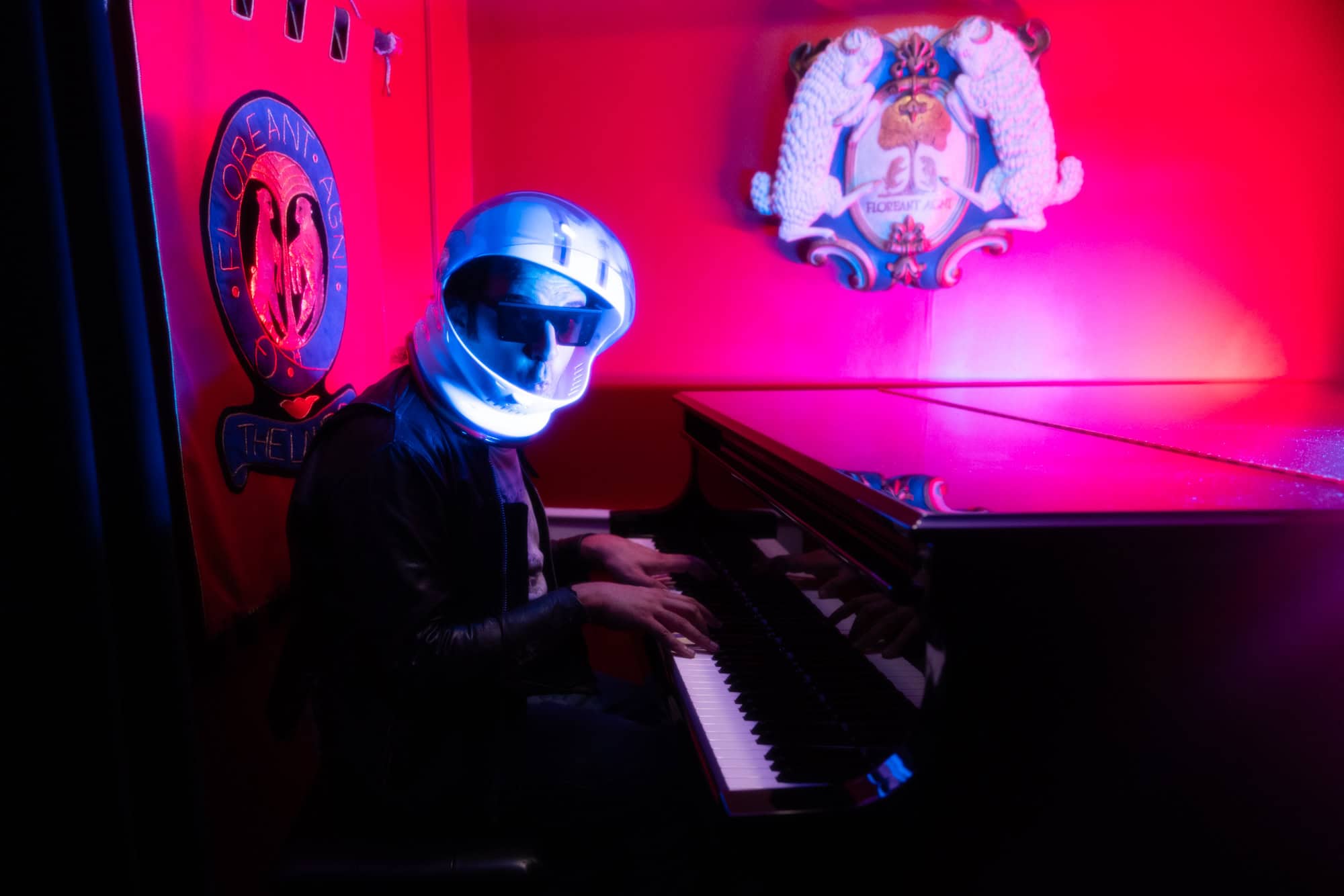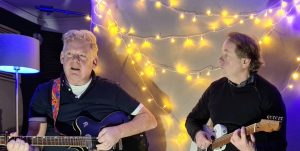Photo credit: Jeanette D. Moses
A decade after its original release, Matt DeMello’s There’s No Place Like Nowhere has returned in a remastered anniversary edition, Ten Years Later, offering a fuller, more polished take on his “broken concept album.” Initially a sonic whirlwind of orchestral ambition and lo-fi ingenuity, the record now reaches closer to DeMello’s original artistic vision, bringing newfound clarity to a work that has steadily gained cult status in niche music circles.
Produced with longtime collaborator Alex Busi, the remaster benefits from a decade of advancements in mastering equipment and experience, shedding fresh light on the intricate layers of DeMello’s genre-blurring masterpiece. Inspired by musical mavericks like Brian Wilson and Frank Zappa, DeMello’s work remains unhinged yet precise, a combination of grandeur and eccentricity. Tracks like “An Inkling On a Rooftop/Between Myself and All My Friends” weave influences ranging from Gershwin to Pink Floyd into a complex tapestry of sound, all crafted by one man with a keyboard and a relentless vision.
The album’s thematic heart—a fictionalized tale of a girl grappling with love, substance abuse, and existential malaise in New York City—is a stand-in for DeMello himself. Across 15 tracks, he explores the chaos and catharsis of human frailty with an equal measure of humour and raw emotion. This balance of vulnerability and experimentation has resonated with a loyal fanbase, growing organically through platforms like #freealbumcodes and Japanese noise festivals during the pandemic.
The Ten Years Later reissue expands the experience into a three-disc set. Alongside the remastered album, listeners are treated to demos, Sidewalk Cafe live performances, and studio outtakes, offering a deeper dive into DeMello’s meticulous and unconventional creative process. This broader context highlights the painstaking effort behind an album that dares to aim for orchestral grandeur while embracing its DIY ethos.
As DeMello himself notes, the release is a tribute to the manual, deliberate artistry of its time—an antithesis to the ease of modern AI-assisted production. He reflects on the inevitability of emerging technologies but underscores the irreplaceable value of the painstaking human effort that birthed No Place.
To celebrate the release of There’s No Place Like Nowhere, Music Crowns caught up with Matt DeMello to discuss the reissue in more detail.
What inspired you to revisit and re-release There’s No Place Like Nowhere for its 10th anniversary?
The biggest reason I’m so passionate about this re-release is No Place is by far the album that’s snowballed the most attention for me since release, but it’s also because that initial release could not have been more muted. I really just slapped it on a Facebook post and said “Friends and family, check it out!” and they were … polite. It really wasn’t until the pandemic that I started sending tapes to Spain and Japan.
How has your perception of There’s No Place Like Nowhere changed over the last decade?
I think Alex Busi (producer) did an amazing job with the remaster, and it really brings out the sort of Soft Bulletin side of the arrangements—not just leveraging synthesizers but really the broad capabilities of the mid-fi studio we had at the time.
You described There’s No Place Like Nowhere as a “broken concept album.” Can you tell us more about the story behind it and what you wanted to convey?
The basic idea was sort of a Separation Sunday meets a modern-day, drug-fueled Wizard of Oz… but for atheism instead of Catholicism. I probably only had the concept enough to really make the songs feel attached, and that was the singular purpose of having any concept.
The outline had this sort of redemption story about a girl who goes on a bender after she finds out she can’t have kids. She goes to a friend’s wedding back home and hits rock bottom with a member of the catering staff at “that beach” from high school, from which she sort of lands on this atheistic sense of forgiveness the morning after. I think that much of it the listener can pick up on.
There were flashbacks and a few other plot details, but they were not worth developing other than making the record feel like this sort of lost movie soundtrack. I was really into The Caretaker at the time and wanted to get that same sense of “this is what the characters are listening to” that they made inspired by The Shining. In a way, our approach was more like Born to Run, but the characters listen to a lot of what I put on mixtapes in college. So Gershwin and Built to Spill.
How did the Sidewalk Café’s anti-folk community impact your music and inspire There’s No Place Like Nowhere?
Oh man, “How did not?” is way easier to answer. How much time do you have? Maybe the easiest way to summarize is that we’re having Pete Dizozza open the No Place tenth anniversary show at the Lambs Club with his mini-opera “The Afterdeath.” I saw one of their performances this past summer at Theatre for the New City on the Lower East Side and was absolutely blown away.
I always tell people, “I want to be Pete when I grow up.” No Place, in many ways, is me applying for that job and ending up with a few other ones I’ve enjoyed over the years.
You work in AI market research. How do you think the AI and automation developments will influence the future of music creation?
A big reason I wanted to do this reissue is that I’m starting to see a musical tech landscape that would have offered someone like me ten years ago a different set of options for the same ambitions that gave No Place its scope. This would have led to radically different and arguably less authentic results.
Whatever popularity the record has really took off in electronica music circles on Twitter over the pandemic for the same reason it made a lot of my friends and family kind of shrug when I put it out — those synthesizer string arrangements either scratch that Jazz From Hell itch for you or they sound like some haunted amusement park.
Either is fine with me as the songwriter, but the more passive audiences of the internet probably don’t have patience for especially the latter. They may have been more interested in a version of No Place with more authentic-sounding acoustic instruments instead of the wall-of-synthesizers approach. This is an audience that we, as researchers, are noticing will probably be more accepting of music made with AI-driven sounds and arrangements or have a less nuanced sense of the “uncanny valley.“
If I were writing and recording the record now, I’d be a lot more tempted to leverage some sort of data tool where I could say, “Take this piano track I’m playing and make it a symphonic string arrangement behind the piano,” rather than executing the same idea with a synthesizer. I was not especially passionate about translating electronic music to orchestral at the time; I just wanted a bigger arrangement and had limited resources.
I remember when Panic! At the Disco came out in college. I said things like, “It sounds like they bought a Casio keyboard at Radioshack and made an emo album for theater kids.” Five years later, I was doing the same thing, mostly to get away with not having to work with other people.
And by traditional classical composition standards—me, AI composers, Panic—we’re all cheating! Union rules for symphony musicians up until the late 20th century disincentivized legitimizing mellotrons and other synthesizer-adjacent string imitations over trained, academic-supported talent.
All to say that there’s something authentically 2010s about the studio-as-songwriter ‘s-instrument approach of the record: it may not have seemed as fleeting of a moment at the time, but that’s also so much of the grief everyone’s feeling with AI right now: It means we’re moving into a world where the rules are fundamentally different from when we started playing the game, or at least when we were children growing up. It can engender a sort of species-fundamentalist attitude that’s not all that different from far-right populism and immigration. I’ve just elected to hold off from that degree of bitterness.
I’ll instead grieve synthesizers and fake orchestras the same way the Caretaker grieves phonographs and the special hiss of 45s. That sounds like more fun for me.
You spoke of the album as a celebration of manual, painstaking work in music-making. How important is that process to you in today’s digital age?
I’m not going to die on the hill saying these manual processes are immortal and represent some apex of music creation. It’s tempting, but I’ve had too many people say the same thing about me, whether I was coming up in school or in the New York City music scene.
That said, I think there’s a line you can draw from the original song-cycle artists, Van Dyke Parks and Randy Newman or so — and even some prog and early electronica music like Rick Wakeman and Wendy Carlos — compare that all to what Alex and I did and say, “Here’s the progress of how far anyone’s taken the composer/songwriter using the studio-as-instrument approach as far as it can go.” That much I could not be more proud of.
I’ve gotten blocked by some friends on social networks for expressing apathy about the rise of digital tools in creative work, but the truth is it really seems stupid to draw lines that say, “How dare anyone use a generative talk-to-audio tool to write string parts?” when you just don’t know what kind of talent that’s going to unleash.
Yes, there will be crap. There will always be crap. I should know, I came of age as a listener in the post-grunge era of Limewire. But who am I to deny all the Robert Pollards who are going to make something wild and ridiculous with these tools when I’m the guy who made No Place? Any Berklee orchestral arrangement major has every right to call me “fake” as much. And when I was in school, they often did.
It doesn’t mean anyone has to enjoy it, but I don’t have the heart to look down on AI tools as a means to an end. I’m much more judgmental and less forgiving about the ends, which depend entirely on the artist.
That’s where I have the most fun as a creator, designing the ends to reflect my inner reaction to the world and then deciding what the means say about them later.
Reflecting on the last 10 years, what have you learned about yourself as an artist? And what can fans expect from your upcoming music?
If I haven’t already taught everyone by now that the entire discography is nothing but completely self-indulgent left turns, I don’t know how else I can make it more obvious.
Buckle the fuck up, losers. We’re here to explore the full spiritual terrain of the self through the arrogance of my ego.
Do you have any advice for independent artists hoping to explore complex, genre-blending sounds like those in There’s No Place Like Nowhere?
I would say never think of it as genre-jumping. Think of it as being as receptive as possible about two things: The first is your own attitudes and moods about life. If you write songs for all your emotions and experiences, even the ones you’re ashamed of, the music always ends up getting called “eclectic” in a way that’s honest and doesn’t sound like you’re chasing trends.
The same goes if you get a lot of inspiration from writing for specific audiences or different kinds of musicians you work with. Other musicians, especially, are a big motivator for me when I’m writing: How do I make a piece that conveys this ultra-real talent of someone in my network to the audiences that I’m able to reach?
And I recommend taking the same approach: What’s the widest range of audiences I can write for on a given LP-length statement? What’s the widest range of talent in my network I can feature on a single track? Think in those terms, think in terms of serving those audiences, musicians, and ends, not just checking boxes that you think make you different. Those are the best ways I’ve found to do anything unexpected with integrity.






